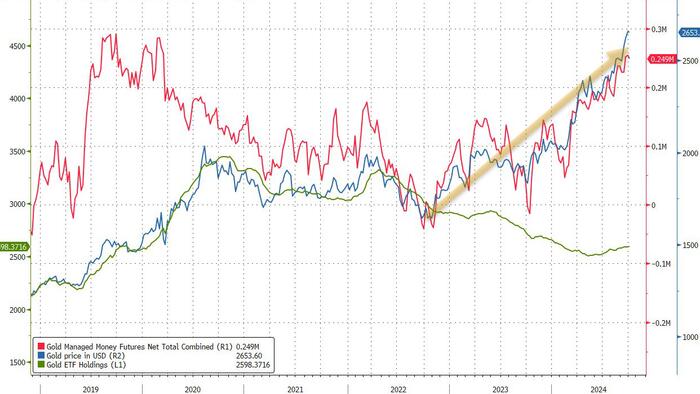In a recent presentation, Eric Peters, CIO of One River Asset Management, examined the psychological dynamics surrounding the gold market, especially in relation to bitcoin. He began by reflecting on the impact of quantitative easing (QE) during the Global Financial Crisis (GFC), which prompted many investors, notably Baby Boomers, to seek gold as a hedge against anticipated massive monetary inflation. This demographic felt particularly vulnerable at the time, having significant savings they feared might be devalued. As a result, gold became an attractive investment option, with many Boomers acquiring substantial amounts. The market response was rather subdued in the years following, partly due to political resistance to aggressive fiscal measures in the U.S. and external factors like China’s growing influence and its deflation-exporting economy.
Peters noted the peaks and troughs of gold prices during key historical moments. Gold reached a high of over $2500 per ounce in 2011 and subsequently fell by nearly 40% by 2015. Many investors who had bought gold during its boom years were left disappointed and burned, waiting for an opportunity to recover their losses. When the market rallied again in July 2020, driven by COVID-19 stimulus measures, some investors sold their holdings, only to watch gold prices decline again. Over the following two years, the price dipped by approximately 30%, leading to widespread negative sentiment among Baby Boomers who had held onto gold, some of whom even became bearish after witnessing geopolitical events such as the EU’s confiscation of Russian reserves.
However, a significant shift in market dynamics occurred when the last remaining disillusioned investors sold off their positions. Following this cleansing of stale market engravings, gold began to ascend once more. Peters highlighted the importance of “clean markets” that can respond aggressively to favorable catalysts, noting that gold had at least two underlying factors propelling its recent upward trajectory. One key driver was the broader trend of governments looking to diversify their foreign reserves into non-sovereign assets, including gold, particularly highlighted by the confiscation of Russian assets. As central banks globally embraced stimulus measures rather than austerity, gold’s performance began to reflect an environment where scarce assets would gain in value.
Peters made an interesting comparison between the performances of gold and bitcoin, which have exhibited starkly different trends despite some overlapping market fundamentals. While gold has gained approximately 40% over the past year, bitcoin has skyrocketed by 134% during the same period. However, he observed that bitcoin’s price seems to have stagnated over the last seven months, staying within a 30% trading range and hovering about 13% below its all-time highs. Peters reflected on the exuberance surrounding bitcoin, particularly when it hit $59,000 in April 2021, followed by a dramatic price decline of nearly 50% in the summer months. Subsequent market fluctuations led to new highs of around $65,000 later that year, only to crash again after the FTX debacle, resulting in a painful experience for many bullish investors.
The psychological impact of volatility on bitcoin holders creates a paradox when analyzing market behavior. Following its ascent to $72,750 in March, there has consistently been selling pressure among investors, indicating lingering trepidation. Peters pointed out that this reaction may stem from the emotional scars left by previous crashes, with many investors now hoping to sell portions of their holdings should they regain previous highs. This hesitance to hold the asset, despite favorable market conditions, parallels the behavior seen in gold investors during bearish periods but represents a stark contrast to the unfolding dynamics for gold, which has enjoyed an upswing without the same anxiety-induced selling pressure plaguing bitcoin.
In conclusion, Peters provided a nuanced overview of how the psychological landscape around gold and bitcoin has shaped their market trajectories. Gold’s recent recovery can be largely attributed to a purge of skeptical investors and a perception shift towards non-sovereign assets. Meanwhile, bitcoin’s upward movement is tempered by the caution and emotional baggage of its holders, resulting in a unique market footrace, where gold has taken the lead. As the economic landscape continues to evolve, with increased stimulus and geopolitical uncertainties, Peters suggests that both assets may still find avenues for appreciation, albeit through contrasting investor psyches and behaviors. This psychological interplay will likely remain a key component of investment strategies as both gold and bitcoin chase new peaks in a complex economic environment.

